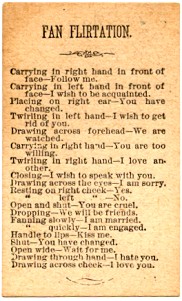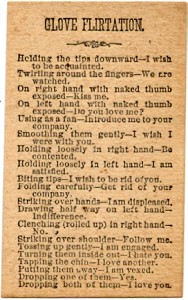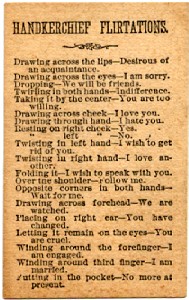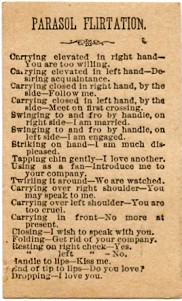Myth Information - The Fan Code
- Jonathan Walford

- Mar 7, 2022
- 2 min read

Fans were practical accessories for cooling the face and hiding yawns, and they were used as personal flirtation devices at Victorian social events. However, other than furtive glances from behind a fluttering arc of painted silk and carved ivory, any naval flag-like language code based upon how a fan was opened, closed, held, or pointed is a complete fashion myth.
Fans had been a standard part of 18th century court life, but when the French Revolution took out the elite, the trappings of court life also fell from popularity, including the use of fans. Just as fans were making a comeback, Jean-Pierre Duvelleroy opened his Parisian fan-making shop in 1827 at 15 Rue de la Paix. By the 1850s Duvelleroy was known as one of the best fan makers in Europe. He opened a London branch which he left to his illegitimate son Jules to manage, while the Paris atelier remained under the operation of his legitimate son, Georges.
The language of flowers, a code for certain blooms corresponding with particular messages or emotions, was a popular fad at this time and often printed up in little booklets. Jules Duvelleroy adapted this idea as an advertising gimmick for his London fan shop. He printed up leaflets that identified a number of fan movements that he claimed had meaning and had been in use for centuries. Some of the codes were: ‘Follow Me’ (carrying the fan in front of face), ‘You Have Changed’ (placing the fan on the right ear), ‘We are Watched’ (drawing the fan across the forehead), ‘I am Married’ (fanning slowly), ‘I Love You’ (drawing the fan across the cheek)…
The language of the fan became the inspiration for a number of similar clothing codes, including the language of the handkerchief, parasol, and gloves, none of which were ever anything more than a gimmick. The idea of a clothing code resurfaced in the gay community in the 1970s, with coloured hankies worn in different manners to indicate sexual preferences – but even that was a short-lived, and not widely understood, code that was more decorative than informative.











